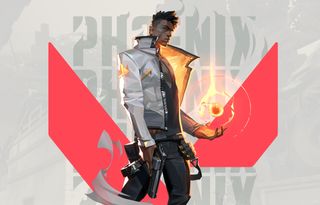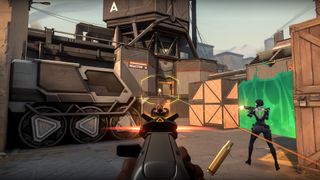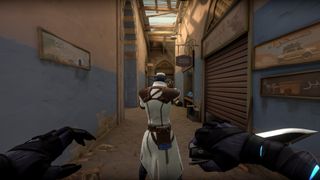Valorant hands-on: How Riot plans to woo FPS diehards with the best netcode and anti-cheat
Valorant, Riot's first departure from League of Legends, is a surprisingly traditional competitive shooter.
Huddled alone in a corner near bomb site A, I knew I didn't have a chance of sneaking in and planting the package strapped to my back. The defense had just wiped out the other four members of my team, and they knew the bomb was close. They'd be waiting to dome me as soon as I stepped around a corner. So instead I activated my ult, an ability I'd been charging up for half a dozen rounds. After a tense, vulnerable few seconds, I teleported clear across the map to bomb site B and armed the bomb, adrenaline pumping at the thought of pulling off a 1v4 upset.

Valorant release date: When will it fully launch?
Valorant characters: All the hero abilities
Valorant ranks: How you'll be progressing
Valorant system requirements: Can you run it?
"Unloseable!" said League of Legends shoutcaster David "Phreak" Turley, who was helping my team of journalists learn the basics of Valorant, Riot's new competitive shooter. Unloseable for him, maybe. It was meant to be encouraging, but unfortunately Turley underestimated my ability to choke under pressure. The defense raced to my bomb site and I fumbled my other remaining abilities, throwing down smoke clouds that blinded me as much as they did them. Instead of hiding to scare off an attempted disarm, I went in—and down—guns blazing. They had just enough time to defuse my unloseable victory.
I'm still mad I blew my chance at glory, but the thrill of that moment has stuck with me. It showed how dramatically a well-timed ability in Valorant can alter a match, and made me think okay, maybe Riot has something here. Because at first, I wasn't so sure. Hero abilities allow for clever strategies and exciting upsets, but look past them, and Riot Games has fundamentally spent the last five years building Counter-Strike.
Teamfight tactical
I didn't expect to be pulling out a knife to run at top speed in a game released in 2020.
Valorant is a 5v5 tactical shooter, meaning you move slowly, die real fast, and lose any semblance of accuracy when you try to run-and-gun. Weapons have heavy recoil, made more manageable when you stand still or crouch. Bullets penetrate doors and light cover. One round, one life, with one team trying to plant a bomb and the other trying to stop them. You even buy guns and armor at the beginning of every round and run faster with your knife (there is, of course, no sprint). These have been the fundamentals of Counter-Strike for 20 years.
Seriously—when I went to Riot Games to play its first new thing set outside the League of Legends universe, I didn't expect to be pulling out a knife to run at top speed in a game released in 2020.
"When you think of everything from old Rogue Spear, to Counter-Strike 1.4 and Counter-Strike 1.6, and even Rainbow Six: Siege now, they're all playing in this tactical tradition of games that force you to play as a team and think about how you're going to break through an enemy line and conquer it. What we really liked is that concept," said game director Joe Ziegler. "The bits and pieces that we took inspiration from we've molded into our own to create a package that we feel is very unique, but really we were thinking about how to expand on the creativity of it. Because in a lot of those games, historically, it's a game of inches."
The parts of Valorant that aren't pure Counter-Strike are similarly unoriginal. Character abilities feel straight out of a game like Overwatch (or League of Legends), but are scaled way back to only a few uses per match. Riot emphasized, again and again over two days of playing Valorant and talking to its creators, that the shooting is the main course and the abilities are the side dish. "An obvious default for us would be like, oh, just give agents all the abilities every round," said lead game designer Trevor Romleski.
The biggest gaming news, reviews and hardware deals
Keep up to date with the most important stories and the best deals, as picked by the PC Gamer team.
But that's not Valorant. Each character has a single core ability they can use repeatedly—while two others have to be bought and replenished each round, and can only hold a few charges. In the hands of a newcomer, trying to use them in a firefight is liable to get you killed. It only takes a few bullets to put you down, even with armor. But a wall of poison or a flashbang that curves around a corner can completely upset an encounter in the hands of a pro. Their rarity does make them crucial, if you're not bumbling around with a bunch of beginners.
"What we wanted to introduce is a targeted pace for the game," Romleski said. "We didn't want the first round to be this crazy explosive moment where tons of agent abilities are flying out, and we wanted some of the things that you [buy] in the game to be meaningful. So if you die, that actually impacts your economy. You may have to compromise on your weapon to get more abilities or vice versa. So we think that just enriches decision-making when you play, but ultimately it serves as a pacing mechanism for us where total ability use goes up as more money is introduced."
All the character designs follow a clean, athleisure/streetwear aesthetic that stays firmly grounded compared to the likes of Fortnite or Apex Legends. The diversity of the cast I got to see—8 out of at least 10 who should be available at launch—was great, and Riot's artists are clearly talented. But Valorant has a not-quite-comfortable combination of urban cool and real military (including bland gun models and real weapons like the AK-47) that ends up disappointingly restrained.

But that aesthetic, like the rest of Valorant, seems to have gone through an agonizing amount of consideration. Each character's lower body is deliberately simple in design to draw the eye upwards, and the colors and shapes of their torsos, clothing and hair are all tuned to frame the head so that every character, and every player, is on even footing.
Maps are designed with the same thought process, with sparse decorations at eye level, to keep the focus on the characters. The two maps I played did have bits of decor that experienced players will be able to use to easily call out locations, but they're deliberately placed to minimize distraction. If you die in Valorant, it's not likely going to be because you got caught on some jutting geometry, either. Function always comes before form.
This may be common practice for FPS designers these days, but it ties into the common theme everyone at Riot spoke about when showing off Valorant: Fairness. The big pitch wasn't that Valorant has bold new ideas, that it's going to be flashier or more creative than any other shooter. The big pitch is that Valorant is going to be fair. So fair that it bursts into flames outdoors without sunscreen. So fair that even the feistiest referee won't find any excuse to throw a yellow card.
And it's going to accomplish that with really, really good netcode and anti-cheat software.
Netcromancers
When it comes to the technology of Valorant, Riot has a deck's worth of aces up its sleeve. First ace: 128 tickrate servers. The faster the tickrate, the more frequently the server updates the game state—sending the locations of players and bullets and so on to each client computer. It makes everything more accurate and responsive, because all that data is being updated every 7.8125 milliseconds.
By comparison, CS:GO's matchmaking runs on 64 tick servers; Rainbow Six: Siege runs at 60. Many games operate with even lower tickrates: Fortnite is 30, while Apex Legends seems to be only 20. Why? Double the tickrate and you double the server load, which means you need twice as many servers to run the same game.
"Running a 128 tick server is unrelenting," said Riot's engineering manager David Straily. "Anyone can do it on a micro scale, but to do it for everyone, gobally, is where it's really expensive. We have to actually run multiple 128 tick servers per game core on our CPUs. What that means is theoretically, if you ran our server uncapped, it has to be at about a 500 FPS server tickrate… if we could only run one game server per one server CPU on an actual physical computer, that'd be prohibitively expensive."
Second ace: Riot Direct, an ambitious internet infrastructure initiative the company launched for League of Legends five years ago. Even if you have a fast home internet connection and a 128 tick server, it's irrelevant if your packet takes a slow, circuitous path to get where it's going as ISPs prioritize other traffic. Riot basically built its own internet backbone, installing routers all over the world and signing deals with major ISPs to rout Riot's game traffic directly across their network, rather than the open internet. Valorant can make use of the same network, meaning at least 70 percent of its players, at launch, will have a ping of less than 35 ms. "No other game has something like this," Straily said.
We're really looking at how you re-fix the puzzle with all these characters. How's every game completely different?
Joe Ziegler
Third ace: Anti-cheat factored into the very design of the game. Riot integrated an anti-cheat team into Valorant's development before it even went into pre-production, and they vetted every design choice for its potential hackability. It's server-authoritative, so a player's client can't disrupt a match with a cheat saying "I'm invincible." But many cheats are more sophisticated than that. Anti-cheat lead Paul Chamberlain gave a basic example: Your crosshair doesn't turn red in Valorant when you aim at an enemy, because a hack could read that pixel and instantly pull the trigger, guaranteeing a hit.
Even what it feels like to fire a gun in Valorant was influenced by the anti-cheat team. "When we were talking about how recoil for guns should work, we spent a lot of time discussing how much to trust the client. Because if you trust the client, then you can write a cheat that ignores recoil," Chamberlain said. "However, if you don't trust the client, it becomes this prediction problem, where you might look like you've shot a bullet accurately on your computer, but the server disagrees, and tries to find a balance. For the most part, we've landed on the very secure end of the spectrum, but there's always a trade off."
Chamberlain showed off a particularly cool bit of anti-cheat design that functions like a "fog of war" system, but for the game's netcode. Instead of constantly updating your client with the locations of enemy players, the server waits until just before they're actually visible to send that data. It was a challenge to implement without slowing down the game's performance, which had to stay lightning quick to support those 128 tickrate servers. But the fog of war rules out major wallhacks and other "ESP"-style cheats that show cheaters where their enemies are from a distance.

Fourth ace: A particular dedication to mitigating peeker's advantage, an eternal challenge in online competitive shooters. You can read more about what peeker's advantage is, and how Riot plans to eradicate it, in a longer interview with Straily here.
Valorant's developers want you to trust, absolutely, that when you died, there was no hanky panky. That when you fired a bullet at someone's head, the hitbox was exacting, and lag didn't rob you of your headshot. And they seem to be banking on the idea that competitive shooter players, people who love games like Counter-Strike and Rainbow Six: Siege, will be drawn to a game that stonewalls cheaters and uses the fastest servers in gaming. Its bona fides are undeniable.
But is that really enough to make people want to play it?
Shots fired
Valorant is going up against games that already have millions of players. Maybe enough of them are disgruntled by network issues or simply bored of the same old, same old, and that'll give Valorant a healthy audience. But it's still surprising that Valorant hews so closely to what's been done before, with its big draws being fairness and reliability. Will that really work on players who are, at this moment, contently shooting it out on de_dust2 for the 30,000th time?
Well, League of Legends made that bet by adapting a Warcraft 3 mod, and it became the biggest game in the world. So maybe Riot knows what it's doing.
Like Joe Ziegler said, getting better at tactical shooters—learning the right defensive rotations, controlling recoil just a hair more accurately—is traditionally a game of inches. Maybe iterating on their design is, too.
"We're really looking at how you re-fix the puzzle with all these characters," Ziegler said. "How's every game completely different? Instead of walking in and going, 'they're guaranteed to have three smokes and two molotovs in this location.' Now it's like, 'they have this set of characters, these are the sets of strategies they might employ. How do we work against that?'"
With an obvious eye on Counter-Strike, Valorant's designers want its maps to be playable for 10,000 hours without players getting sick of them. No pressure, right? But in tactical shooter terms, anyway, the map designs are a little bit radical. They look like they could've been pulled straight from Counter-Strike, but the differences are significant—they'd seem gimmicky if they weren't exhaustively tested by Riot's developers to prove their replayability. One map I played on had a game-changing three bomb sites (gasp) instead of two, and the other had a pair of one-way teleporters that opened the door to creative feints and ambushes. Both were fun, felt very different, and hint at how Valorant could forge its own identity in the details.
"There's no wall in our workspace that says 'demolish CS:GO' or 'take half of Overwatch's players," added executive producer Anna Donlon. "Those aren't our success criteria. I think there are a lot of players out there who haven't found their shooter of choice yet. Or they find one they like for a while and bounce off of it. Maybe we're for them. We're definitely not going to be for everybody. We know that for sure."
Whoever Valorant's for, I think at least one thing's safe to say: their ping is gonna be great.

Wes has been covering games and hardware for more than 10 years, first at tech sites like The Wirecutter and Tested before joining the PC Gamer team in 2014. Wes plays a little bit of everything, but he'll always jump at the chance to cover emulation and Japanese games.
When he's not obsessively optimizing and re-optimizing a tangle of conveyor belts in Satisfactory (it's really becoming a problem), he's probably playing a 20-year-old Final Fantasy or some opaque ASCII roguelike. With a focus on writing and editing features, he seeks out personal stories and in-depth histories from the corners of PC gaming and its niche communities. 50% pizza by volume (deep dish, to be specific).
Most Popular

